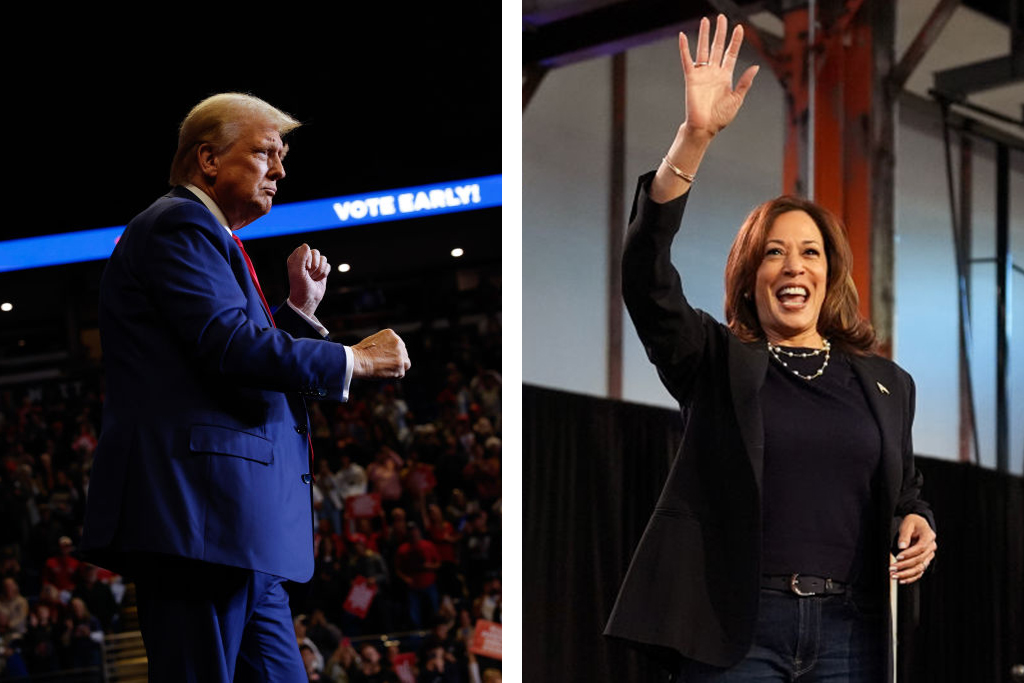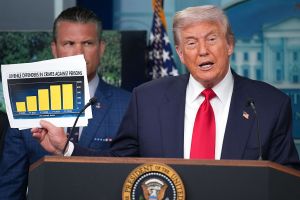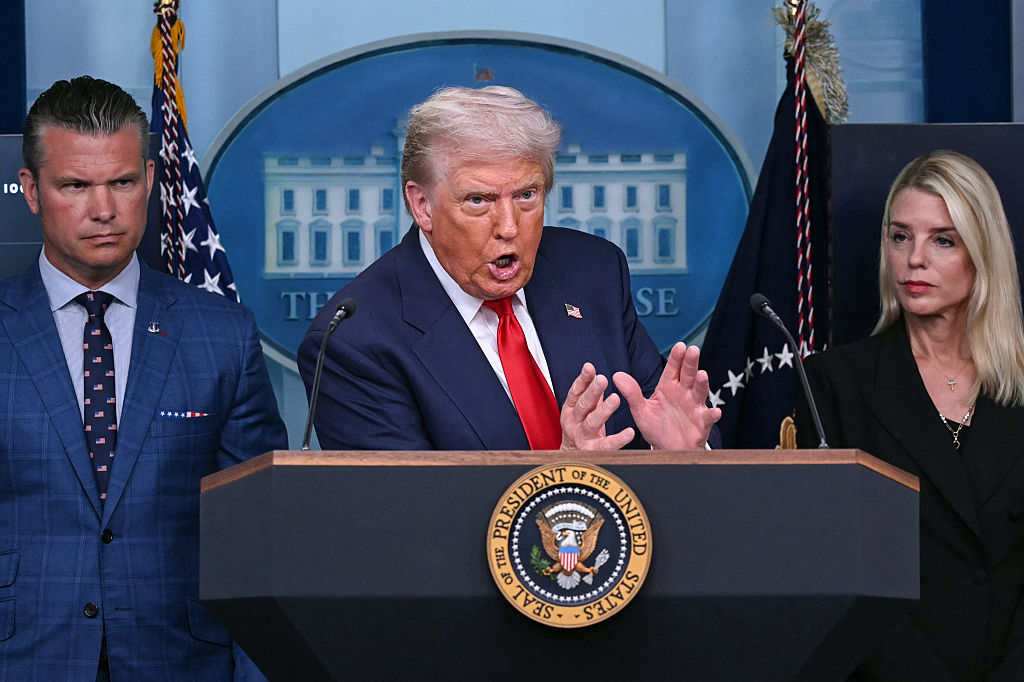It’s easy to summarize the two sides’ closing arguments. For Kamala Harris, the closing argument is “Trump is really, really bad.” Asked to expand, it is “Trump will end abortion rights” and “Trump is a fascist.” For Trump, the argument is, “Things were great when I was president, and I will make them great again.” Asked to expand, it is “I will be better than Washington and Lincoln. Everybody says so.” And “Kamala is a left-wing nut job.”
After discounting the hyperbole (a gargantuan task), how is the final stretch going? Rocky for Democrats, encouraging for Republicans. That’s the message from polling trends and political betting markets. The polls are essentially tied in battleground states, but have moved slightly in Trump’s favor. The odds, which favored Kamala Harris as the fresh nominee, now say Donald Trump has a greater than 60 percent chance of winning. It is virtually certain Republicans will win the Senate, which is crucial for confirming all presidential appointments. The House is a toss-up.
The grim faces at MSNBC and CNN tell a similar tale. So do ads for local Democrats in swing states. They seldom mention Harris, never mention Biden and stress areas of agreement with Trump, such as energy and trade (not immigration). None call him a fascist, as Harris does. Instead, they include positive references to the former president and virtually beg his supporters to split their tickets.
These messages are a sea-change from the early, heady, positive days of the Harris campaign. The joy she once proclaimed is dead and buried, replaced by angry tirades against Trump. The message is almost entirely negative. “Trump is unstable.” “Trump is dangerous.” “Trump will pass a national abortion ban,” something he has explicitly opposed. Harris says little about her own positive agenda, aside from abortion. She blames the immigration crisis on Trump and says very little about her future policies on immigration or other issues.
Kamala’s message, “A New Way Forward,” is vague, but that’s not damning, in itself. All campaign slogans are. The problem is that it doesn’t work well for her for a couple of reasons. First, it is a claim best made by political outsiders like Barack Obama in 2008 (“Hope and Change”), not sitting vice presidents. Second, when you are part of the incumbent administration and promising something new, you have to say what it will be. Harris hasn’t done that and apparently cannot. It is not enough to laugh and say, as Harris has on late-night talk shows, “Hey, just look at me. I’m not Donald Trump or Joe Biden.”
The failure to answer crucial questions is why the unscripted interviews are now gone. They were always “Hail Mary” passes for an inarticulate candidate. They failed. When you can’t answer tee-ball questions on The View, it’s not a good strategy. Still, she tried a little longer and failed again. “Word salad city” was David Axelrod’s description of Kamala’s Wednesday appearance with CNN’s Anderson Cooper.
After those train wrecks, what’s left? Scripted rallies. Harris is spending the last week on stage with popular singers, Michelle and Barack Obama, reading whatever her speechwriters wrote, and hoping the teleprompter doesn’t break down. When it broke a few weeks ago, all Kamala could do was repeat the last scripted line until technicians fixed the scroll. It was embarrassing.
She also failed by staging a scripted event and calling it a “town hall.” The pro-Harris audience arrived expecting to engage with their candidate, off the cuff. No such luck. As the program began, the hapless audience was told all questions for Vice President Harris had been “pre-determined.” When a candidate fears answering questions from ordinary citizens who already support her, she is truly inept.
Undecided voters have seen enough. So have many voters who would ordinarily “lean Democratic.” The more they see of Harris, the less they like. The only remaining question is how many low-propensity Democratic voters reach the same conclusion. If they do, she’s sunk.
Her best chance is to widen her huge edge with women voters, flood the airways with attack ads — she has far more campaign cash to do that than Trump does — and rely on the Democrats’ strong ground game to get out the vote.
Where does that leave Vice President Harris’s closing argument? With three lines of attack:
- Kamala will protect “women’s reproductive rights”; Trump will undermine them
- Trump is only for the rich. His tax proposals prove it. Her ads drive home the point by showing him in a tuxedo
- Trump is a threat to democracy, a wannabe dictator, a fascist
The Democrats’ focus on abortion rights is clearly helping them. The other lines of attack are not.
The claim that Trump is only for the rich is failing for three reasons. The first was obvious to anyone who watched video last weekend of Trump cooking fries and serving customers at McDonald’s. He was completely at ease among workers and customers. It was a brilliant marketing ploy, showering him with free media for days. Second, the elitist party Harris is attacking is not the one Trump has forged. He built a populist, working-class party, closer to Harry Truman’s Democrats than to Herbert Hoover’s plutocrats. “Tuxedo Trump” is not an image voters have of the former president. Her last-minute ads won’t change their minds. Finally, attacking Trump’s proposals as “solely for the rich” misses the vital point Americans saw at their kitchen tables. Their incomes increased and necessities were more affordable. They care a lot more about how their families are doing than about some hypothetical distribution of future benefits to others. According to survey after survey, voters say they were doing better under Trump (until Covid). Today, they complain it is harder to pay for groceries, gas, clothing, and housing.
Harris may be more successful with her other line of attack, saying Trump threatens our democracy. That argument relies on Trump’s refusal to acknowledge the results of the 2020 election or condemn the mob invading the Capitol on January 6. He amplified those fears recently when he spoke about “the enemy within,” naming people like Representative Adam Schiff, who is favored to win an open Senate seat in California. Trump often speaks of admiring foreign dictators.
For many Americans, those are ominous signs of how Trump would govern. It is one thing to call political opponents “adversaries” and quite another to call them “enemies.” It is one thing attach that label to rioting anarchists and transnational drug cartels and quite another to say the same thing about elected representatives. That virulent language crosses a line most voters rightly consider a basic norm for functioning democracies, where political control should be transferred peacefully between parties, both of them legitimate.
These multi-pronged attacks on Trump mobilize Democrats and persuade about 45-48 percent of voters. But the betting odds show they don’t convince enough independent and moderate voters. Why? Mainly because they are deeply dissatisfied with the country’s direction and reluctant to embrace a high-ranking incumbent who seems to be part of the problem, not part of the solution.
To win over those voters, Harris needs to demonstrate qualities that seem to be missing:
- A high level of competence
- A clear policy vision, different from the unpopular Biden administration
- A mastery of policy details, and
- A capacity to articulate both the details and the larger vision
The last week of the campaign is too late to do that.
What about Trump’s closing arguments? They are a mix of positive and negative claims, with a large dollop of showmanship and exaggeration. The negative arguments stress Harris’s deep ties to the unpopular Biden administration and her inability to say anything she would have done differently. That’s damning when almost 80 percent of voters think the country is on the wrong track.
Trump is also advancing a positive agenda in ways Harris is not. That agenda is one the strongest factors motivating voters, both for and against the former president.
Among Democratic activists, the biggest negatives, aside from abortion, are Trump’s blustering, outsized personality (a turnoff among many women voters, especially educated professionals) and the fear he will become a dictator, unconstrained by the Constitution or American institutions. Trump’s 2024 campaign has done nothing to allay those fears about democratic stability. Indeed, he has often compounded them.
Democratic insiders share those fears and add one more, without stating it publicly. They are deeply concerned about Trump’s goal of rolling back the administrative state, with its vast network of regulations, promulgated mostly by mid-level bureaucrats.
The Democrats built that state — it is one of their crowning achievements—and they are determined to defend it. They are the party of government and have been since FDR. Although they promote the regulatory state as necessary and politically neutral, many voters think the regulations have gone too far, ignore the onerous costs, pursue progressive goals and lack effective democratic controls.
Rolling back this vast, undemocratic apparatus will be one of Donald Trump’s overriding aims as the 47th president. It was one of Ronald Reagan’s aims, too, but he merely succeeded in delaying its growth for a few years. Trump’s aims are more ambitious, and the Supreme Court has begun offering some assistance, requiring congressional authorization for the most far-reaching bureaucratic regulations.
What are Trump’s other big goals as the 47th president?
- Restoring American manufacturing, the essence of his protectionist tariff policy; that could win bipartisan support since Democrats seem to agree with that agenda;
- Rebuilding the American military and the defense-industrial base,
- Encouraging more domestic oil and gas production,
- Making conservative judicial appointments,
- Vastly reducing the number of federal bureaucrats and their regulatory power; and
- Reasserting control over the border, stopping illegal immigration and deporting violent gang members
None of that will be possible if the permanent bureaucracy and their supporters in Congress can block Trump, as they did during his first term. Asserting presidential control of the federal bureaucracy is not dictatorial, as long as it is done within the law. After all, the only elected officials in the Executive Branch are the president and vice president. Choosing them is the only way voters can exert democratic control.
Asserting that control means appointing White House aides, cabinet secretaries and high-level deputies who are both competent and committed to the president’s goals. Not one or the other. Both. Trump didn’t accomplish that in his first term. Second, he must gain control over the two powerful bureaucracies that could sink him, as they did last time. Those are the intelligence community and federal law enforcement (the Department of Justice and the FBI).
Gaining that control does not mean turning the DoJ and FBI into partisan instruments or tools of retribution. At least it shouldn’t. Nor does it mean launching a lawfare crusade against political opponents, as they did against Trump. It means restoring impartial justice, without fear or favor.
No task is more important for the new president than restoring Americans’ confidence in our government’s basic fairness, integrity, competence, and democratic control. That means the president’s actions must be constrained by the Constitution and duly passed laws.
The frailty of those institutional guardrails is why both parties are playing with fire when they attack the supporting wall of our constitutional structure and their legitimacy. That’s true whether it is contesting duly certified election results or proposing to pack the Supreme Court.
Restoring those guardrails and buttressing the public’s confidence in them should be a major goal for both parties and a central feature of their closing arguments. Alas, it is not. Each side simply points at the other and screams “They are the problem. It’s all their fault.”


























Leave a Reply